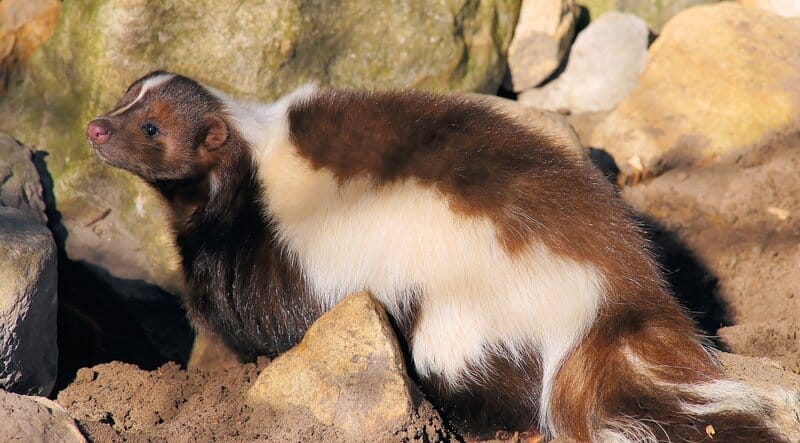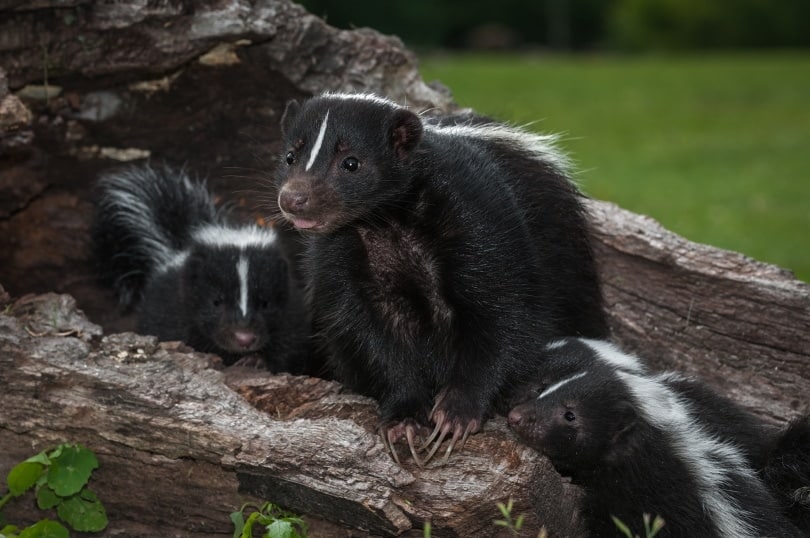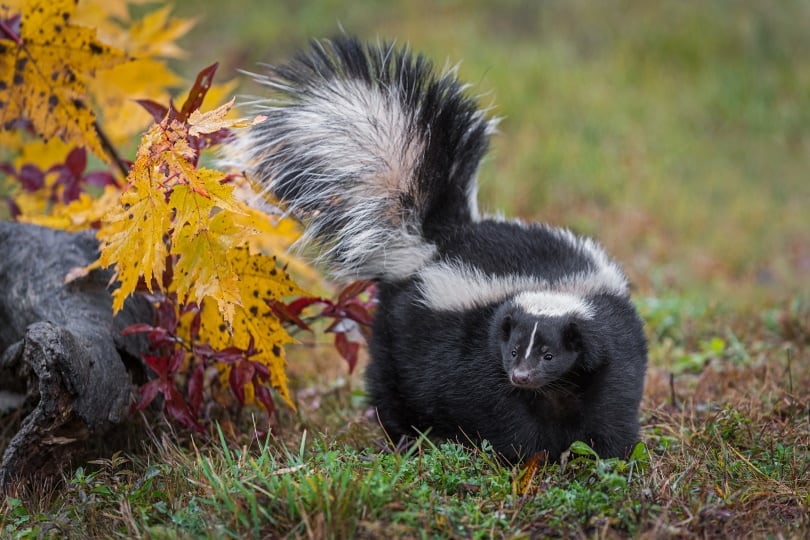Skunks are adorable little black and white animals full of curiosity, and often mischief!
Skunks are sensitive, intelligent, and highly curious animals that can fascinate and frustrate. They are very smart and pretty, but shunks can spray an incredibly powerful, stinky odor to defend themselves. Wild skunks can be a benefit, however, because they will eat many pesky insects that can damage lawns and gardens.
A skunk pet may be an unusual choice, but most owners view them as ingenious and wonderful. Due to their limited availability, restrictive laws in some areas and being a more difficult animal to care for, pet skunks are rather rare. They may be available from pet stores either as babies in the springtime, or as surplus skunks from large fur farms, and will generally have their scent gland removed.
Temperament will vary with each individual skunk. Baby pet skunks need to be gently handled on a frequent basis to become docile adults. Most can be housebroken, but due to their inquisitive nature, they will soon be opening all your cupboards. A benefit derived from wild skunks is that they will eat many of the insect pests that can damage your lawn or garden.

Skunks are Intriguing Creatures
by Elizabeth Gatto
The skunk is a carnivorous mammal that has long been famed for its strong stinky odor. However, there is so much more that is fascinating about this creature than just its scent! The skunk falls under the Musteloide super family that belongs to the mephitidae family under the California class.
Skunks vary in size and weight, with common lengths being between fifteen and thirty seven inches on average. Their weight ranges between one half to eight kilograms for full grown skunks depending on the specific species. Their bodies are moderately elongated; their legs are relatively short but well-muscled, with strong front claws that they deploy when digging underground for food or shelter. The elongated bodies arise from the shape of their skeleton, which has adapted over the years to different living conditions in the wild and in urban areas that they have lately moved to. If you happen to find or smell a skunk on your property, such as under your shed and do not know how to remove it, you can contact a professional skunk removal expert to do it for you.

The most common coloration among skunks is black and white, but brown and cream are also fairly common. All skunks have the striped coloration that makes them unique, and these stripes are visible even at birth. The stripes may vary, with some having two stripes, some having one stripe, while others have dense patterned marks that form a stripe in continuity, which is more common with the spotted skunks pictured above. The striping gives them a bright coloration that helps humans uniquely identify them in the wild, and is an adaptive feature that warns predators against attacking them.
The skunk is a largely solitary animal, although it may at times be seen in a group. The skunk mates during early spring, with successful males mating with several females. They are placental mammals and have a gestation period of about sixty six days. During breeding, the mother skunk moves away from the group to raise her young, but males do not have any role in child rearing. However, skunks regularly congregate together during the day when there is plenty of food to be dug in the burrows, or during cold evenings when females come together for warmth.
Both sexes of skunks occupy overlapping territories; with females having two to four square miles while males may occupy territories as large as twenty square miles. Although skunks may be quite dormant during the winter, they are not true hibernators. They generally show little activity during this period with little feeding, and will tend to use the same den for many winters in a row if it is available.
The skunk is a gifted omnivore, feeding on a wide variety of plant and animal material depending on location, season, and availability. When it comes to food, the skunk devours a wide range of meals including insects, insect larvae, digging up earthworms, small birds, eggs of different creatures, frogs, rodents, lizards as well snakes and moles. The skunk is both a gifted hunter and an opportunistic feeder, adjusting its skills depending on the situation at hand to ensure survival. Skunks also feed on a number of plant materials including berries, grasses, fungi as well as nuts and roots.

The skunk is also a sworn eater of garbage left behind by man as their omnivorous nature brings them closer to the human diet, allowing them to frequent bins and garbage sites wherever they have such a chance. Foraging on our leftovers has even been cited as one of the core reasons skunks are frequently spotted in suburban areas. They are smart, sporadic scavengers that can be spotted in garages and other places hunting for pet food, especially when such food is not properly secured. It is extremely important to keep your food secure and out of reach of skunks.
Their smart hunting skills have made them the primary predators of bees, deploying their thick fur as an effective defense against stings by the bees. The skunk tactically invades the beehives and waits for the guard bees to come for inspection after which it takes them up for a meal, with mother skunks being credited for teaching this skill to their young ones.
Skunks possess a strong sense of smell as well as hearing capability, but their vision is highly underdeveloped and is regularly to blame for their death in traffic. The skunk’s average life span is seven years in the wild, but a larger proportion dies before age three.
Skunks do make good pets and in captivity, they have been reported to have an average lifespan of up to ten years.
The skunk is feared for its unrivalled ability to spray a liquid that the human nose can detect at two miles distance. Skunks spray when they feel their security is threatened or endangered. It is important to appreciate that the strong odor of the skunk is simply a defense mechanism and not a reason to harm the animal.
Author Elizabeth Gatto’s goal is to protect wildlife when it accidentally enters peoples’ homes. If you need help with an animal on your property you can hire a dedicated wildlife control professional that uses humane control methods, such as live trapping and relocation.
Do you have a skunk story you’d like to tell? Simply sign up on Pet Talk and join in!
Join us on Facebook too! Pets, Animals, and People: Our World United
Featured Image Credit: Bryan Padron, Unsplash
